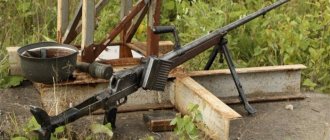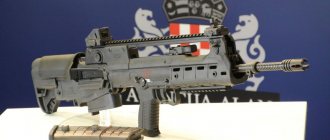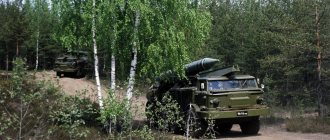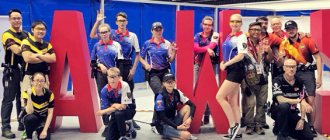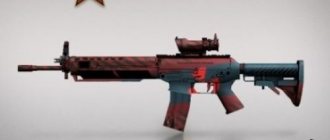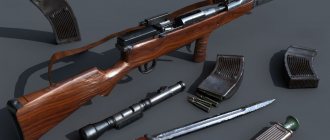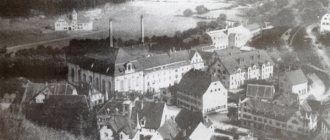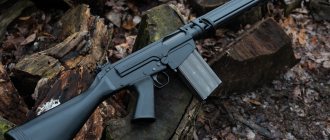Weapon evaluation
In general, we can say that ideologically the SV-98 is like two peas in a pod like its foreign “colleagues” - the American Remington 700, the German Blaser 93 and the like. It is not outstanding, but not bad either - an ordinary sniper rifle with ordinary characteristics. Its main value for the military lies in the use of standard ammunition, inherited from the SVD. The development and production of a new sniper cartridge could significantly burden the Russian military-industrial complex; this process would last for years.
SV-98 at a sniping competition. Photo: Commons.wikimedia.org / CC-BY-SA 3.0/Vitaly V. Kuzmin
And so everything turned out very successfully: there are cartridges in warehouses, the design of the rifle itself has been “tested” by athletes over decades to the point of failure - that’s definitely hitting the bull’s eye! The rearmament process has already begun (the first rifles arrived in units back in 2011), and we can say for sure that the SV-98 will open a new chapter of military sniping in the Russian armed forces.
The SV-98 sniper rifle was developed at the KTC of the IZHMASH concern (currently part of the Kalashnikov concern) on the basis of the 7.62mm Record-1 sports rifle. It was adopted by the Russian Army under the designation 6B10; it is also used by special forces of the Ministry of Internal Affairs and other law enforcement agencies of Russia. Serial production began in 2000; since 2013, a modified version of the rifle with an updated skeleton-type stock has been produced. When using 7N1 or 7N14 sniper cartridges, the rifle provides a shooting accuracy of less than 1 arc minute, the effective firing range is. depending on the type of target, 800 meters or even more.
The SV-98 sniper rifle uses manual reloading with a longitudinally sliding rotary bolt with 3 lugs in the front. The cartridges are fed from detachable plastic magazines of the original design, holding 10 cartridges when placed in a double row. The design of the magazine reliably protects bullets from deformation when carrying and reloading the weapon.
The trigger mechanism is of a sport type, with adjustable trigger force. The 6B10 rifle is standardly equipped with open sights - a front sight in the front sight and an adjustable rear sight. Initially, the 6B10 rifle was equipped with a PKS-07 optical sight of fixed magnification 7X with illuminated reticle; currently it can be equipped with various day and night sights. mounted on a Picatinny rail made on the upper surface of the receiver.
Early versions of the SV-98 rifle had a stock made of wood laminate with a characteristic butt of a skeletal design. Modern versions are equipped with an aluminum stock of skeletal design with a side-folding adjustable stock. The stock has a mount for a folding bipod and swivels for a gun sling. A flame arrester or a quick-detachable shot silencer can be installed on the muzzle of the barrel.
SV-98 sniper rifle with folded bipod
As part of the work on a new complex of sniper weapons (the "Burglar" theme), Russian gunsmiths carried out development work on sniper systems of various calibers - 7.62 mm "Vzlomshchik-7.62", 9 mm "Vzlomshchik-9", 12.7 mm "Burglar-12.7". One of the results was the entry into service of special forces in 2003 of the 6S11 sniper complex of 7.62 mm caliber, including the SV-98 repeating rifle (index 6B10) and the 7N14 cartridge with a bullet of increased penetration (although other versions of the 7.62 cartridge can be used ×54, including sniper 7N1 or sports cartridge “Extra”).
The rifle is in service, in particular, in the units of the Ministry of Foreign Affairs of the Russian Federation.
The SV-98 sniper rifle was developed by the designer of the Izhevsk Machine-Building Plant V. Stronsky on the basis of the “large-caliber” sports rifle (according to the sports classification) “Record” - CISM.
The rifle barrel is made by cold radial forging using imported technology with honing treatment (finishing machined parts to the required cleanliness with abrasive stones) and relieving internal stresses. The barrel is cantilevered in the receiver and hangs freely, that is, it does not touch the stock or other parts of the rifle and is not loaded with a bipod mount (the so-called “free-floating barrel”). This ensures the constancy of its fluctuations, which can be taken into account when zeroing. To improve shooting accuracy, the barrel bore is not chrome-plated. The muzzle of the barrel has a thread for attaching a low-noise shooting device (LSD). If the muzzle device is not installed, the threads are covered by a bushing that protects the threads.
The magazine design of the rifle made it possible to eliminate impulse loads characteristic of automatic (self-loading) weapons. In addition, when working with a repeating rifle, there is no knocking of automatic parts, it is possible to control the movement of the bolt (which helps, for example, to avoid the shine of an ejected cartridge case or to send a cartridge into the chamber more smoothly). The longitudinally sliding rotary bolt has three lugs in the front part, and a reloading handle deflected downwards in the rear part. The front end of the middle lug serves as a cartridge rammer during the reloading process. In the locked position, the charging handle is located above the trigger guard on the right, which makes it easier for the sniper to operate it. An ejector with a spring is assembled in the bolt, the reflector is located in the receiver.
The impact mechanism is striker type. The firing pin with the mainspring is assembled in the bolt channel. The firing pin is cocked by turning the reloading handle while unlocking the bolt, which increases the safety of the weapon during the reloading process. The trigger mechanism is assembled in a separate housing, mounted in the receiver. The trigger force is adjustable within 1.0-1.5 kgf. The trigger mechanism is smooth and has a small trigger stroke. The non-automatic safety lever is mounted on the right behind the bolt handle, and when turned on, blocks the sear, trigger and bolt.
Food comes from a box-shaped detachable middle magazine with a capacity of 10 rounds with a double-row arrangement that does not protrude from the stock. The magazine body is cast from glass-filled polyamide and reinforced with metal liners and has a lever feed mechanism. When installing the magazine, a special vertical rod, pressed into the receiver, fixes its correct position. When attaching the magazine, the latch mounted on the rod engages with a metal sleeve reinforced in the opening of the magazine body and presses the magazine tightly against the receiver. This ensures simple, stable and reliable mounting of the magazine on the rifle.
The optical sight bracket is mounted on top of the receiver on a stepped Picatinny-type rail. The main sight is a pancratic 1P69 (“Hyperon”). The sight provides automatic setting of aiming angles at ranges from 100 to 1000 m. The field of view of the sight with amplification factor 3x is 7.6°, with amplification factor 10x – 2.5°. The sight has a rubber eyecup, a protective hood and a lens cap, and a reticle illumination device. Other sights can also be installed, for example, the PKS-07 sight with a constant magnification of 7x. There is also an open mechanical sighting device, including a front sight with a safety lock (when brought to normal combat, the front sight is adjusted vertically and horizontally) and a variable sight, designed for ranges from 100 to 600 m. The declared effective firing range is 800 m.
The stock is made of pressed plywood board. The butt is adjustable in length (within 20 mm), and the “cheek” (comb - rest under the cheek) and the back of the butt are adjustable in height (within ±30 mm) and lateral displacement (±7 mm). The cutout of the butt is designed to be held with the left hand when shooting. In front of the forend, a height-adjustable bipod is attached to a longitudinal rod; in the stowed position, its legs fit into the forend. An adjustable rear support is attached to the stock. To prevent the shooter from holding the sight when carrying the weapon, a carrying handle is attached to the stock. An option with a plastic stock was also offered.
To protect the field of view of the sight from a thermal “mirage,” a wide nylon tape can be attached above the barrel, and a special visor can be attached above the PMS. SHUYU not only reduces the sound pressure level and eliminates the flash of a shot's flame, but also plays the role of a muzzle brake, reducing the recoil impulse acting on the shooter.
The new 7N14 sniper cartridge of the 7.62×54 type is a development of the 7N1 and is distinguished by a bullet of increased penetration with a hardened pointed core and is superior to the 7N1, primarily in its ability to hit targets in personal armor protection.
Options are available for 7.62×51 (.308 Winchester) and .338 Lapua Magnum cartridges; the rifle is equipped with a stepped “Weaver rail” (Picatinny rail) on top of the receiver.
Tactical technical characteristics of the SV-98
Caliber: 7.62 mm Cartridge: 7.62 x 53 R Weight without cartridges, silencer and sight: 5.5 kg Length (without silencer): 1200 mm Barrel length: 650 mm Combat rate of fire: 10 rounds/min Sighting range: up to 1200 m Magazine capacity: 10 rounds Yuri Maksimov photo by the author
Like many models of domestic small arms, the SV-98 rifle has been the subject of countless discussions since its introduction. The rifle was evaluated both by comparison with the three-line sniper and SVD, and with available imported analogues. After the first few years of operation of the SV-98 in special forces, a more or less clear opinion was formed among snipers about the new product.
This article
could be written based on an analysis of the use of the SV-98 by snipers of various law enforcement agencies, but such materials are available and have been repeatedly analyzed by the interested public. Therefore, an assessment of a rifle without direct reference to the specifics of combat use, so to speak, “through the eyes of a hunter,” based on some personal experience, seemed to be a more acceptable format for presenting the material. It didn’t quite work out, but it is what it is.
I’ll point out right away
that an almost identical analogue of a combat rifle (called “Record”) can also be purchased by a civilian user.
Design Features
Just in case,
Let us recall the design features of the rifle. So, the SV-98 sniper rifle, the prototype for which was the Record-CISM army sporting rifle (built, in turn, on the basis of the 1-shot high-precision Record rifle chambered for 7.62x54R), is designed to destroy targets at range up to 1000 m. SV-98 is a weapon of highly qualified snipers and is not intended for arming conventional army units.
Reloading is carried out by a longitudinally sliding bolt,
with cartridges fed from a ten-place detachable magazine. The design of the weapon allows the installation of almost any modern optical sights. To attach them, a Picatinny rail is made along the top of the receiver. The 1P69 sight is used as a standard sight. The PKS-07 optical sight is also installed. The rifle is equipped with open sights.
Fuse
blocks the travel of the trigger, locks the sear and bolt. The trigger mechanism allows adjustment of the trigger force.
Stock SV-98
it is convenient for shooting from any shoulder, has adjustment of the length of the butt, the position of the back of the head and the comb of the butt vertically and horizontally. The stock is equipped with a quick-release bipod in the front part of the fore-end and a bipod in the butt. In the stowed position, the bipod folds into the fore-end and butt and does not protrude beyond the dimensions of the stock.
To reduce the sound level of a shot
, reducing recoil energy, eliminating muzzle flash, the SV-98 can be supplied with a tactical silencer. The free-floating barrel is made by rotational forging. The package also includes a case, carrying handle, and anti-mirage tape. In terms of technical dispersion, the rifle is equivalent to the best models of sporting weapons. The accuracy of combat with high-quality cartridges is about 50-70 mm at a distance of 300 meters. Effective firing range is up to 800 meters.
Developers
Rifle development
was carried out under the leadership of the head of the design bureau of the department of the chief designer of IZHMASH Vladimir Dmitrievich Stronsky. Designers Nikolay Andrianovich Mitryukov, Leonid Nikitovich Sterkhov and Mikhail Yuryevich Golovanov took direct part in the work. After Stronsky retired, production support and modernization of the SV-98 was carried out under the leadership of Golovanov.
SV-98. We hold it in our hands.
When you first pick up the SV-98,
then you immediately understand that even taking into account possible modifications, this rifle is not very suitable as a classic hunting weapon - its dimensions and weight are not very conducive to this. I do not take into account those mountain hunts where accuracy (especially the first shot) is more important than relative compactness and low weight - horses, mules and donkeys have not yet been canceled, and there are still people who carry 6-7 in the highlands without any problems -kg rifle and 30-kg backpack. Of course, there are specialized rifles for long-term hunting in the mountains, but this is a separate topic for discussion.
Bolt group and trigger
Shutter SV-98
has three symmetrical lugs and, as is typical for domestic weapons, is very simple in design and can be easily disassembled for maintenance. Locking is done on the lugs in the receiver. The role of cutting off the second cartridge (the flange is required) is performed by a special bolt part located at the bottom of its stem. A cocked firing pin is indicated by a cocking indicator located at the rear of the bolt (determined tactilely and visually). The extractor is spring loaded.
But from a “modern” spring-loaded reflector
the designers refused. This has drawn criticism. Moreover, what is noteworthy is that, first of all, criticism came not from direct users of weapons, for whom normal manipulation of the shutter usually does not present any difficulties, but from Internet theorists. The reliability of the SV-98 reflector is beyond doubt, which is confirmed by practice. And let’s not forget that the ability to dose the force of reflection of a cartridge case is an important factor when using sniper combat weapons. And hunters often prefer to take the spent cartridge with them. It doesn’t matter if it’s for later re-equipment or as a keepsake.
Gate surface
has a cadmium coating. This is a fairly rare and expensive material, so it is rarely used for applying protective coatings. But such a coating, in its protective properties, is superior to zinc and best protects the metal product from corrosion, incl. – in difficult operating conditions. And in our case, the cadmium layer also serves to reduce friction of the bolt stem when moving in the receiver of the rifle. For reference: for the first time at IZHMASH, cadmium coating was used on the trigger of the Nikonov AN-94 (Abakan) assault rifle.
Receiver SV-98
has a complex shape. The lower part of the box has multi-directional transverse ribbing. In combination with laying the “iron” in the stock with epoxy resin-based mastic, fins have a positive effect on the positioning of the “iron” in the rifle stock, stability and accuracy of combat. Laying the receiver in the stock with mastic is exactly what has been practiced in domestic factories for several decades and now bears the fashionable borrowed Western name “bedding.”
USM rifles
has the ability to adjust the stroke length and trigger force. The trigger is ergonomic and has a longitudinal notch.
Shop
Shop
with a double-row arrangement of cartridges. The body is made of polyamide, the feeder is metal. The magazine fixation is interesting - in the shaft there is a vertical guide in the form of a rod, along which the front part of the magazine slides when it is removed and attached to the weapon. The magazine is securely secured to the same rod with a transverse spring-loaded clamp. To remove the magazine, you need to press the large release button and remove the magazine downward.
For a shooter familiar with SVT and SVD,
Filling the SV-98 magazine with cartridges does not cause any difficulties. Attaching a magazine requires minimal skill and is even somewhat simpler than attaching a magazine to an SVD.
SV store
has an original feed mechanism, but is easy to maintain and, as mentioned above, absolutely reliable. At least, I have never heard about problems with supply to SV-98 (from a representative number of users), starting around 2005.
Fuse
Lever type fuse.
It is located where the rifle's safety should be - in the right rear part of the receiver. Turns on and off by moving forward and backward. Convenient, understandable, simple and reliable. No complaints.
Trunk
The SV-98 barrel bore is not chrome plated,
which is uncharacteristic for Russian military weapons. This is explained by the higher accuracy of the barrel without chrome coating, which distorts the geometry of the barrel. Critics of the SV-98 argue that for the sniper the “black” barrel causes additional problems associated with the need for more careful maintenance. But the snipers themselves (we are talking about special forces units) do not see any particular problems in this.
Interestingly,
If there is a conversation about the effectiveness of the SV-98 and “in general,” then snipers are inclined to believe that the SV is more suitable for the so-called. “police” operations, but for “war” a semi-automatic is still more acceptable. And we are talking specifically about SVD.
SV-98 barrel survivability
quite high. There are known specimens that have fired about 10 thousand rounds and continue to fire with sufficient accuracy.
The barrel is hung,
those. does not come into contact with the rifle stock anywhere. There is a thread on the muzzle of the barrel, which makes it possible to mount both a full-fledged muffler (everyone calls it “tactical”) and a powerful flame arrester (we are talking about a coupling that covers the mounting cone of the muffler).
Possibility of using anti-mirage tape
more relevant for varminting and benchrest, although it can certainly come in handy in the mountains. Special forces snipers on combat missions usually refuse to use tape.
Open sight
"Mechanics"
It is represented by a traditionally adjustable vertically and horizontally adjustable front sight in the front sight and a drum-type sight, “cut” up to 600 m, with adjustment increments of 100 m. Everything is done simply and reliably, the sight is quite convenient, despite its auxiliary purpose. At least, when shooting standing (from a sling), a chest target from an open rifle sight can be hit without problems at a distance of 300 m, and a tall target can be confidently hit while lying down at a distance of 500 m.
If someone claims that “mechanics” is unnecessary
on a combat rifle - let this remain his personal “modern” opinion.
Optical sight
Unfortunately,
Instead of the Hyperon, the rifle was equipped with a PPO 3-12x36F - an optical pancratic sight, with illumination and a reticle similar to the PSO-1. Those. - quite a military device. The sight was outwardly completely unpresentable (in this regard, not much different from a well-worn rifle), but at the same time it showed acceptable performance. Yes, there was some yellowness and cloudiness of the “picture”, because the sight had long ago lost its seal (if it was there initially), but this did not have a particularly critical effect on accuracy (at relatively close distances).
Any optics can be installed on the rifle,
with suitable fastenings. The “torn” Weaver rail caused some confusion, although, on the other hand, we can see exactly the same separate seats on many modern rifles. But, I repeat, installing optics on a rifle is not a problem. According to unverified information, subsequent releases of the SV-98 received a full-fledged “rail” along the entire length of the receiver.
Stock and bipod
Stock SV-98
It has an ergonomic design, is made of high-quality veneer and has a range of adjustments to suit almost any user. The sporting past of the rifle and its current purpose are reflected. The idea of using bipods that can be retracted into the fore-end is not new and was well implemented in the example of the SV-98.
The rifle's stock has sparked online debate.
But critics' attacks on the material of the SV-98 stock are unfounded. The same Germans still use veneer on their sporting high-precision rifles (for example, “Anschutz”). Veneer is an excellent, stable and, importantly, “warm” material, almost ideal for precision weapons. Plastic, no matter how it is advertised, cannot be compared with veneer, that’s a fact. Non-believers can always put their cheek to the plastic butt in the cold of 30-40 degrees and talk about their feelings. The problem with veneer stocks is that now they have stopped making normal veneer, and it has become very expensive. This is why the original “ZIP” Soviet veneer sets of stock and fore-end overlays for SVD are now so valued, and so often there are counterfeits made from ordinary laminated plywood.
Convenient removable handle
for carrying weapons, located in the center of mass of the rifle. For some types of hunting it may not be superfluous. Somewhere there was criticism about the nuts securing the handle to the stock, but in practice these “wings” do not interfere.
Shooting. Accuracy of SV-98
SV-98 rifles
are accepted by the military acceptance office (customer's representative) based on the results of shooting at 300 (three hundred) m. In this case, the dispersion should not exceed 90 mm, which fits into the notorious Western standard - 1 MOA (about 30 mm at 100 m). Simply put, the accuracy of the rifle meets all modern requirements. If it is possible to use selected ammunition (it doesn’t matter, a good “Extra” or self-assembled), “98s” that have not been shot into trash show results at the level of 0.5-0.75 MOA.
Our rifle
confidently fired groups of 5 shots within 1 arc minute (there were gaps of up to 1.5 MOA due to the fault of the shooters) with the 7N1 cartridge at distances from 100 to 300 meters. “Extra” flew more closely: consistently less than 30 mm per hundred, at 300 m the result was within the expected 90-100 mm, but to obtain the maximum result at this distance there were no longer enough capabilities of the sight. With fairly fast shooting with optics, a chest target up to 600 m is hit without misses. A target the size of a person’s head, even with a poor “Extra” sight, can be hit at a distance of up to 400-500 m, but taking into account adjustments. In such conditions, the need for a really good scope is most acute.
"Dulnik" works well
– no flash is observed at dusk. The store has no complaints. Reloading is smooth and there is no need to apply any effort (the bolt group has not undergone any grinding or fine-tuning). Considering the small amount of fire the rifle has fired (500 rounds), there is also no need to talk about any significant natural grinding in. The descent is beautiful - the sporting past of the SV-98 shows. Thanks to the comfortable and individually adjusted stock and the significant weight of the rifle, recoil is practically not felt, shooting is a pleasure and gives the shooter confidence in his abilities.
Summary
Is SV-98 suitable?
(that is, its civilian version in the form of “Record”) for hunting and, in general, for sporting use by our fellow citizens? The answer is simple and obvious: yes, it does. In the same way as all models of domestic military and conversion weapons in civilian use have been, are suitable and will be suitable (no one has yet proven the opposite).
I don't want to touch on all the details
combat effectiveness of the SV-98, let the “special forces” snipers working with this rifle and Internet theorists argue about this. This article discusses the use of the CB analogue in hunting.
Facts of using “Records”
I personally don’t know about classic driven hunts. But they shoot animals from ambushes, especially when there are more or less significant distances. Enthusiasts also go to the mountains with these weapons. And successfully. Owners of “civilian” SV-98s also shoot at “paper” effectively. Yes, an “almost real” SV costs money and ordering such a rifle is not so easy. But, you see, everyone has their own “wants” and criteria for evaluating weapons and their effectiveness.
In the meantime, the domestic “green rifle”
continues to serve in the Russian Armed Forces and pleases the few owners of the civilian version of the SV-98.
SV-98 (GRAU Index - 6B10) is a Russian repeating sniper rifle, created in 1998-2000. by a team of designers led by Vladimir Stronsky and mass-produced by the Izhmash concern. The SV-98 is designed to destroy enemy personnel appearing, moving, open and unmasked, unprotected and equipped with personal armor protection at a range of up to 1000 m.
The SV-98 rifle is based on the Record-CISM sports rifle. The weapon can be adjusted to regulate the amount of force with which the shooter presses the trigger. The rifle allows effective fire at a range of 700-800 m; at a distance of 300 m, the accuracy of fire is approximately 0.6-0.7 arc minutes.
Options:
- in 2000, a prototype of the SV-98M-338 rifle chambered for the 338 Lapua Magnum cartridge was created
- in 2010, a small-scale production of a civilian modification of the rifle began under the name KO-13 “Record” (there is no mount for a silencer on the barrel).
- in 2013, IZHMASH modernized the rifle. Unlike its predecessor, the modernized SV-98 received a new ergonomic stock made of duralumin alloy.
- in 2014, at the Eurosatory-2014 arms exhibition in Paris, a demonstration sample of another version of the SV-98 was presented - with a lightweight skeleton-type stock, an adjustable butt made of black plastic, folding bipods and a DH 3-12x50 optical sight with a removable thermal imaging attachment " Daedalus-TA2".
It's a club, but it shoots well. The passport contains the best group of 10 shots – 8.8 cm at 300 m. Assembly is in the best domestic traditions. When assembling the shutter at the factory, pins were inserted into the holes from below, and a guide bar was placed on top, which should be attached to the shutter with these pins. When attaching the bolt to the rifle, the bar fell down and jammed the bolt. I could barely make it out. Then I wondered how this bar was attached. Bulky stores, obviously overcomplicated in design. The sporting unified case included is long for a rifle and does not accommodate a rifle with a silencer.
A whole epic happened with the sights for this rifle. They entered the unit only with night sights. So they stood idle. Then one good person gave the unit an expensive Zeiss sight - Diavari 2.5-10-50T. A year later we received PPO 5-15x50. Then, after a considerable period of time, we received a Belarusian POSP 4x12-42W sight with mounts for a Weaver rail. Although the rifle has a Picatinny rail. The locking pins on the scope mount, which prevent longitudinal movement, did not fit the guide on the rifle, which was corrected with a file. It turns out that for a couple of years the rifles were not used for their intended purpose due to the lack of sights.
Sniper rifle SV-98
Published by: zampolit, 09/30/2014, 11:35, Traveler's hobby, 2,352, 0
The history of the creation of this Izhevsk rifle is an example of the sensitive response of gunsmith designers to the requests of special forces and competent interaction between manufacturer and consumer. Until the 2000s, the Russian Armed Forces did not have a decent and inexpensive sniper rifle in their arsenal. The fact that the SVD does not meet the requirements of a sniper’s main weapon has long been clear to professionals. the SV-98 rifle by 1998
To design a new sniper weapon, the Record-CISM sports rifle was taken as a basis.
A flash hider and telescopic bipod were added to the high-precision, massive barrel of a sports rifle, a reliable bolt with a symmetrical arrangement of three lugs, as well as a sports trigger mechanism that ensures stable trigger characteristics. A fuse was installed on the rifle, which in the “P” position blocks the travel of the trigger and stops the bolt from unlocking. The rifle is reloaded manually from a magazine that has been slightly modified. In addition to a mechanical open sight, the rifle was equipped with optics. The bipod folds both forward and backward. When folded back, they are retracted into a special groove on the stock, without going beyond its dimensions. The rifle is equipped with an antimirage tape that eliminates the haze rising from the heated barrel and interfering with aiming. The stock is painted in a protective color, which improves the camouflage properties of the weapon. For rifle shooting, 7.62 mm “Extra” sporting rifle cartridges and 7.62 mm 7N1 sniper cartridges are used. The accuracy of fire with a sniper cartridge is no more than fifteen centimeters in diameter, which corresponds to the accuracy of the best sports weapons in the world. The designers claim that the rifle can also be produced in a version that allows the use of a 7.62x51 (308Win) cartridge, which will subsequently make it possible to introduce the rifle to the international arms market. A big problem is the PKS-07 sniper calimator sight from the Leningrad Optical-Mechanical Association. The sight is very inconvenient to use and extremely capricious. In this regard, calling it a sniper is a stretch. The use of a red aiming mark interferes with aiming when the point in the lens exceeds the size of the target or is equal to it. The image quality is low and even a seven-fold magnification does not make this scope acceptable for a very good, although not yet “brought to perfection” rifle. Tactical and technical data of the SV-98
Barrel length, mm – 650 Rifling pitch, mm – 320 Muzzle velocity – 815 Trigger force, adjustable, kgf – 1.5-2.0 Magazine capacity, rounds – 10 Weight without optical sight, kg - 6.2 Rifle length, mm - 1270 Adjustment amount: butt length, mm - 20 butt comb, mm: vertical +9, - 6 horizontal + 4 butt ridge from neutral.
Positions: up and down, mm -30 right, left, mm 7 Combat rate of fire, rds. per minute — 10 The article by S. Kozlov “New developments in Izhevsk, 2003” was used.
- 0
Description
| The style of this article is non-encyclopedic or violates the norms of the Russian language. The article follows the stylistic rules of Wikipedia. (February 24, 2017) |
The basis for this model was the Soviet sports rifle “Record”, model 1972 in the “SIZM” modification, created after the collapse of the USSR for the CSKA national team, performing under the International Rifle Union program. The SV-98 differs from the Record-SIZM in the presence of a detachable ten-round magazine. The appearance of a multi-shot rifle with good accuracy characteristics chambered for the standard Russian 7.62×54 cartridge attracted the interest of the armed forces. The design of the trigger mechanism allows you to adjust the degree of pressure on the trigger[5].
The SV-98 rifle is built according to the classic design for such weapons: the longitudinally sliding bolt is locked with three lugs; After firing, the bolt must be opened manually to extract the cartridge case and closed, chambering the next cartridge. Manual chambering eliminates the parasitic vibrations of the barrel, which are inevitable when operating gas-operated automatics, which significantly increases the accuracy of fire. The forged barrel hangs freely in the receiver without touching the stock. This allows you to avoid shifting the point of impact with different grips. The stock is made of modified wood, a groove is cut out in the front part for folding a bipod, and a handle for carrying a weapon is attached in the middle. The butt plate and cheek rest are adjustable.
The rifle has a sport-type trigger mechanism. The SV-98 is equipped with a telescopic bipod, anti-mirage tape for the barrel to prevent distortion of the image in the sight by air heated during shooting, a silencer and a 1P69 Hyperon pancratic sight. The rifle allows effective fire at a distance of 700-800 m. In total, the technical solutions of the SV-98 provide it with accuracy of about 0.5–0.7 arc minutes at 300 meters when using special cartridges. An experienced shooter from the SV-98 is capable of hitting a tall target at a distance of 1200 meters. Analogues of the rifle can be called the American Remington 700, the German Blaser 93 and similar rifles.
History of creation
The SV-98 sniper rifle was developed by the Izhmash concern in 1998 under the leadership of Vladimir Stronsky.
The basis for it was the Soviet sports rifle “Record”, model 1972. More precisely, its modification “SIZM”, created after the collapse of the USSR for the CSKA national team, performing under the program of the International Rifle Union; The Record-SIZM differs from its single-shot progenitor by the presence of a detachable ten-place magazine. The appearance of a new multi-shot rifle chambered for the standard Russian cartridge 7.62x54 could not but interest the army. Especially considering the champion accuracy of the Record.
The legendary SVD will soon have to retire to a well-deserved retirement. Photo: Commons.wikimedia.org
The fact is that the SVD rifle, with all its undeniable advantages, is the brainchild of the doctrine of global war. Look at the bayonet mount, which has become the talk of the town! Yes, the Soviet sniper had to go on a bayonet attack along with the entire squad - he was not an independent figure on the battlefield. Accordingly, the requirements for the SVD were army-wide; the rifle turned out to be fast-firing, reliable, very durable, but not very accurate by sniper standards. Let's just say that it is capable of confidently hitting a chest target at 500 meters, but nothing more. Hitting the enemy's head carelessly stuck out at the same distance is already a game of chance.
And if in the 60-80s the lack of accuracy was offset by the imperfection of the sights, then with the development of optics, the potential of the SVD became insufficient. Moreover, the experience of “hot spots” of recent decades forced the command to change their view on the use of the army sniper. From an ordinary fighter who enhances the squad's firepower, he gradually turns into a specialist who solves special problems while being out of reach of enemy fire.
After the Great Patriotic War, the experience of using sniper units in the USSR was gradually forgotten. In the photo, sniper Vasily Zaitsev with recruits. Stalingrad, December 1942. Photo: Public Domain
Instead of standard three-month courses for conscripts, special training centers are being created in Russia; for example, the Solnechnogorsk Sniper Center, which managed to win considerable military glory in a short time (established in 1999). In addition to the art of marksmanship, they teach special tactics, essentially reconstructing and improving the experience of using sniper units in combat, lost after the Great Patriotic War. Of course, SVD is no longer suitable for graduates of these centers.
And if the niche of a silent rifle today is successfully filled by the famous VSS “Vintorez”, and heavy sniper “artillery” by large-caliber monsters, like the OSV-96 “Burglar” or KSVK, then the niche of the main “workhorse” has been empty for a long time. Special forces ordered imported rifles, and military snipers were forced to be content with the SVD, modernizing it at their own expense, buying bipods and modern sights. But even with all the modifications, the Dragunov rifle is significantly inferior to foreign “snipers”. The SV-98 is that very missing link: a mass-produced high-precision weapon for army marksmen.
